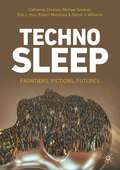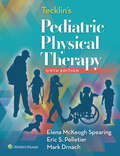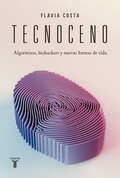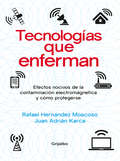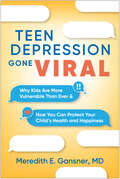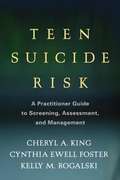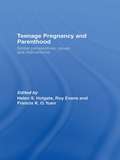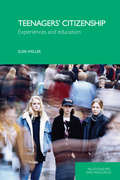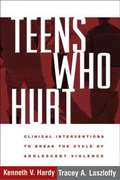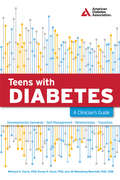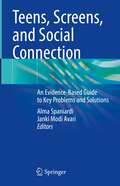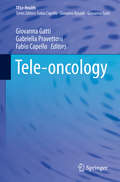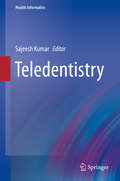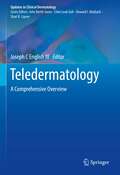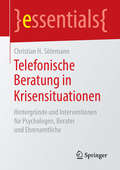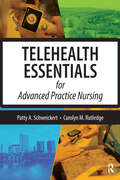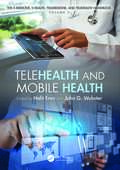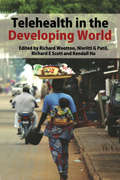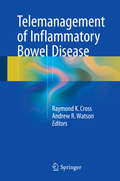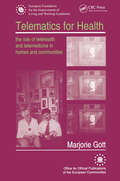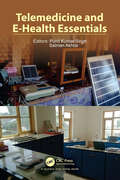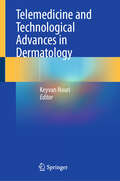- Table View
- List View
Technology-Enabled Work-System Design: Select Proceedings of HWWE 2018 (Design Science and Innovation)
by Rauf Iqbal Vivek Khanzode Bijulal D. Regi Kumar V Suresh SubramoniamThis volume presents selected papers presented during the 16th International Conference on Humanizing Work and Work Environment (HWWE 2018). The book presents a confluence of ideas on ergonomics and technology implementation to improve workplace environments and work systems to maximize effectiveness and performance. The volume is thematically arranged, with papers covering different aspects of ergonomics and design. The volume will be of use to researchers, practitioners and students working in different fields of ergonomics.
Technosleep: Frontiers, Fictions, Futures
by Simon J. Williams Robert Meadows Michael Greaney Eric L. Hsu Catherine CoveneyThis book draws on a variety of substantive examples from science, technology, medicine, literature, and popular culture to highlight how a new technoscientifically mediated and modified phase and form of technosleep is now in the making – in the global north at least; and to discuss the consequences for our relationships to sleep, the values we accord sleep and the very nature and normativities of sleep itself.The authors discuss how technosleep, at its simplest denotes the ‘coming together’ or ‘entanglements’ of sleep and technology and sensitizes us to various shifts in sleep–technology relations through culture, time and place. In doing so, it pays close attention to the salience and significance of these trends and transformations to date in everyday/night life, their implications for sleep inequalities and the related issues of sleep and social justice they suggest.
Tecklin's Pediatric Physical Therapy
by Elena McKeough Spearing Eric S. Pelletier Mark DrnachTrusted for decades by Physical Therapy students as well as experienced therapists who want to improve their knowledge, Tecklin’s Pediatric Physical Therapy provides a comprehensive and logical overview of some of the most common pediatric physical therapy diagnoses. This straightforward approach presents basic medical information regarding common clinical diagnostic categories followed by coverage of physical therapy examination, intervention and special considerations within each diagnostic group. Content in this 6th Edition has been thoroughly updated and reorganized to help prepare students for today’s clinical challenges, accompanied by case studies and interactive features that reinforce understanding and instill the clinical decision-making skills essential to successful practice.
Tecnoceno: Algoritmos, biohackers y nuevas formas de vida
by Flavia CostaDescripción de esta era en la que, mediante la puesta en marcha de tecnologías de alta complejidad y altísimo riesgo, dejamos huellas en el mundo que exponen no solo a las poblaciones de hoy, sino a las generaciones futuras, de nuestra especie y de otras especies, en los próximos milenios. Chernóbil, la crisis financiera de 2008, los incendios en el Amazonas o la pandemia de coronavirus no son eventos aislados. Son "accidentes normales", síntomas del crecimiento y la destrucción acelerados, que, en menos de setenta años, transformaron nuestra vida y la del planeta para siempre. En Tecnoceno Flavia Costa delinea con sutileza la trama cultural y política de este mundoambiente alucinatorio cuya virtualidad se sostiene en una red material hecha de cables, satélites y edificios, por donde desfilan bioartistas, ciencia forense, organizaciones de derechos humanos, sistemas de vigilancia y empresarios transhumanistas. Y advierte sobre el papel clave que cumplen hoy las huellas: las biométricas, las comportamentales y las que dejamos en el suelo, la atmósfera y los océanos. Unas porque su capitalización ha desatado una feroz batalla geopolítica. Otras porque de ellas depende el futuro de la Tierra. «Los "accidentes normales" no son producto de una guerra, una negligencia o un sabotaje, sino que son inseparables de la productividad del sistema, de su desarrollo, de su incremento y de las contingencias que siempre se abren cuando se dispara una acción tecnológica hipercompleja hacia el futuro.» «Estamos ante una nueva cultura del yo que se exhibe ante los demás; un sujeto que, así como asume la individualidad somática, se reconoce también como emisor continuo de señales, como obra viviente, que se experimenta, se expresa, se juzga y actúa sobre sí, en parte, en el lenguaje del espectáculo. Y que se entrena como creador de su propia audiencia.»
Tecnologías que enferman: Efectos nocivos de la contaminación electromagnética y cómo protegerse
by Juan Adrián Karca Rafael Hernandez MoscosoAprenda a cómo protegerse de la contaminación electromagnética. Los aparatos electrónicos se están tomando nuestra vida: vivimos conectados a un celular, un computador, un televisor, una tableta. Hay muchas ventajas del desarrollo pero también hay un lado más sombrío del que pocos hablan: la tecnología moderna tiene efectos negativos en nuestra salud debido a la contaminación eléctrica y magnética que produce. Cada vez la evidencia es más contundente sobre los impactos que tiene en el sistema inmune, el sistema neurológico y la salud mental, entre otros. El propósito de este libro es que cualquiera que lo lea pueda conocer y tomar conciencia de la contaminación invisible proveniente dela tecnología que lo rodea. Este libro revela los avances científicos que se han hecho para determinar los efectos nocivos de estas radiaciones, muestra formas prácticas para protegerse de la contaminación electromagnética y contiene una guía para que el lector determine si es una posible víctima de estas energías.
Teen Depression Gone Viral: Why Kids Are More Vulnerable Than Ever and How You Can Protect Your Child's Health and Happiness
by Meredith E. GansnerWhat are the warning signs of depression in teens? When do social media and gaming habits cross the line into putting kids at risk? How can parents keep teens healthy and safe--without sledgehammering all their devices? This realistic, nonjudgmental guide from adolescent psychiatrist and parent Meredith E. Gansner provides the latest information about depression in teens, with a special focus on digital media use. Filled with vivid stories, the book helps you understand teen mental health problems and self-harm; find an accurate diagnosis; work with your child to develop healthier habits, aided by downloadable practical tools; and make informed treatment decisions. Dr. Gansner explores myths and facts about internet addiction, dangerous viral trends, and cyberbullying, and describes actionable steps for curbing them. Every chapter also identifies positive technology resources for both kids and parents, from supportive online communities to health-promoting sites and apps.
Teen Suicide Risk
by Cynthia Ewell Foster Kelly M. Rogalski Cheryl A. KingMeeting a vital need, this book helps clinicians rapidly identify risks for suicidal behavior and manage an at-risk teen's ongoing care. It provides clear guidelines for conducting suicide risk screenings and comprehensive risk assessments and implementing immediate safety-focused interventions, as well as longer-term treatment plans. Designed for day-to-day use in private practice, schools, or other settings, the volume is grounded in a strong evidence base. It features quick-reference clinical pointers, sample dialogues with teens and parents, and reproducible assessment and documentation tools. Purchasers get access to a Web page featuring most of the reproducible materials, ready to download and print in a convenient 8 1/2" x 11" size.
Teenage Pregnancy and Parenthood: Global Perspectives, Issues and Interventions
by Helen S. Holgate Roy Evans Francis K. O. YuenThe debate of teenage pregnancy and parenthood continues to be a topical media and political issue, and a contested policy area. Covering the controversial issues, this book contributes to the debate, filling the gap in the current market. The strong chapter selection looks at areas such as: education social policy and welfare reforms in the UK and US issues for young fathers child sex abuse girls with emotional and behavioural difficulties. This is invaluable reading for those working on government strategies to reduce teen pregnancies and those working in sex education and youth care.
Teenagers' Citizenship: Experiences and Education (Relationships and Resources)
by Susie WellerThe introduction of compulsory citizenship education into the national curriculum has generated a plethora of new interests in the politics of childhood and youth. Citizenship for Teenagers explores teenagers’ acts of and engagement with citizenship in their local communities and examines the role of citizenship education in creating future responsible citizens. The first half of the book provides the context for teenagers’ experiences of citizenship, discussing issues around the ideas of childhood and citizenship, as well as the curriculum. The second half goes on to explore teenagers’ experiences of citizenship education, practising citizenship and exclusion from citizenship. The book concludes with a call for a new cumulative approach to citizenship which upgrades the status of teenagers, particularly within the classroom. Susie Weller’s important book will throw new light on how teenagers engage with citizenship education and take on civic responsibility. It is an interesting and useful read for all those involved with education and youth policy as well as those studying for a PGCE or researching in citizenship education.
Teens Who Hurt
by Tracey A. Laszloffy Kenneth V. HardyOffering a fresh perspective on treatment, this book presents an overarching framework and many specific strategies for working with violent youth and their families. The authors shed light on the complex interplay of individual, family, community, and societal forces that lead some adolescents to hurt others or themselves. Effective ways to address each of these factors in clinical and school settings are discussed and illustrated with evocative case material. The book provides essential guidance on connecting with aggressive teens and their parents and managing difficult situations that are likely to arise. The strengths-based interventions presented are applicable to a broad range of high-risk behaviors, from bullying and assault to substance abuse, self-mutilation, and suicidality.
Teens with Diabetes
by Michael A. Harris Korey K. Hood Jill Weissberg-BenchellWritten by three psychologists with more than 50 years of collective experience in the field of diabetes and youth, Teens with Diabetes provides evidence-based techniques for clinicians to treat the psychological needs of children with diabetes and help them transition into their teenage years. The authors have provided care to thousands of diabetic teens and their families from initial diagnosis to leaving home for college. Any professional working with diabetic teens, including psychologists, physicians, social workers, dietitians, and nurse educators, needs this how-to handbook for working with what is arguably one of the most difficult populations in diabetes. Topics covered include handling the initial diagnosis of diabetes in teens, talking with young people about diabetes in a manner that is effective and reduces reactivity, improving diabetes self-care, helping families negotiate the challenges of adolescent diabetes, dealing with peer relations, dealing with high-risk issues related to diabetes, and handling with mood problems.
Teens, Screens, and Social Connection: An Evidence-Based Guide to Key Problems and Solutions
by Alma Spaniardi Janki Modi AvariThis book explores the increasingly important intersection of the digital world and mental health in the lives of pediatric and young adult populations. Young people are spending a considerable amount of time on digital screen activities such as social media, texting, and online gaming. The vast majority of teens and pre-teens have access to computers and smartphones shifting social interaction away from face-to-face contact toward online communication. A practical resource, Teens, Screens, and Social Connection provides the reader with a targeted yet comprehensive understanding of a wide variety of internet and media-related topics facing youth today. Chapters include discussions on the developmental view from early childhood to young adulthood as well as the unique racial and cultural issues pertaining to technology and media. The book provides both the challenges of the internet and media to be identified as well as solutions and clinical pearls that can be immediately applied to clinical practice and real-world scenarios. This book is a practical reference that functions as a concise yet comprehensive summary of the most important aspects of this very timely and important topic. It is an invaluable, practical resource for mental health clinicians, as well as students and those professionals who work with youth in other domains.
Tele-oncology
by Fabio Capello Giovanna Gatti Gabriella PravettoniThis book explains how telemedicine can offer solutions capable of improving the care and survival rates of cancer patients and can also help patients to live a normal life in spite of their condition. Different fields of application - community, hospital and home based - are examined, and detailed attention is paid to the use of tele-oncology in rural/extreme rural settings and in developing countries. The impact of new technologies and the opportunities afforded by the social web are both discussed. The concluding chapters consider eLearning in relation to cancer care and assess the scope for education to improve prevention. No medical condition can shatter people's lives as cancer does today and the need to develop strategies to reduce the disease burden and improve quality of life is paramount. Readers will find this new volume in Springer's TELe Health series to be a rich source of information on the important contribution that can be made by telemedicine in achieving these goals.
Telecare Technologies and the Transformation of Healthcare
by Nelly OudshoornWinner of the British Sociological Association Foundation for the Sociology of Health and Illness Book Prize, 2012. This book traces the changes in healthcare implicated in telecare technologies: information and communication technologies that enable care at a distance. What happens when healthcare moves from physical to virtual encounters between healthcare professionals and patients? What are the consequences for patients when they are expected to do things that used to be done by healthcare professionals? What actually happens when homes become electronically wired to healthcare organizations? These are urgent questions that are, however, largely absent in dominant discourses on telecare. Drawing on insights from science, technology, and human geography, this work opens up novel accounts of the adoption and use of new technologies in healthcare. Nelly Oudshoorn shows how telecare technologies participate in redefining the responsibilities and identities of patients and healthcare professionals, introducing a new category of healthcare workers, and changing the kinds of care and spaces where healthcare is situated. This book intervenes critically into discourses that celebrate the independence of place and time by showing how places and physical contacts still matter in care at a distance.
Teledentistry
by Sajeesh KumarTeledentistry is of growing interest to the healthcare world. Over the last few years, momentum is growing in research and service in Teledentistry - mostly carried out by tertiary medical institutes across the world. While Teledentistry is advanced in some sub-specialties, it has high potential to receive more attention from general communities, dentists, dental hygienists, physicians, nurses, researchers and students. For the first time, this book will present essential knowledge from experts in this field. They will discuss the current status of technology and service in various Telledentistry sub specialties and its future implications. Written by experts from around the globe, (i. e. , from USA, Europe, Australia and Asia), this book presents technical issues and clinical applications. It includes collective experiences from dental service providers in different parts of the world practicing a wide range of Teledentistry applications. This book lays the foundations for the globalization of Teledentistry procedures, making it possible for dental service to be delivered anywhere in the world.
Teledermatology: A Comprehensive Overview (Updates in Clinical Dermatology)
by Joseph C English IIIThis book offers a comprehensive and the foundational structure for all healthcare professionals developing, practicing, and performing research in teledermatology. The chapters of this book examines the field of teledermatology and will include: platforms and practice models, the impact of COVID-19, the telehealth and mobile teledermatology industry, the effect on healthcare accessibility, equality, specialty referrals and no-show rates, cost effectiveness, implementation, regulations and reimbursement, practice guidelines, outcomes for skin lesions, inflammatory dermatoses, inpatient consultations and pediatrics, research utilization, education, image quality and artificial intelligence, global and international efforts as well as patient and physician satisfaction. Chapters are authored by leaders in the field of dermatology and teledermatology. The goal is for the reader to become knowledgeable and proficient within field of teledermatology to increase patient access, manage skin disease and develop beneficial outcomes via electronic consultations.Teledermatology: A Comprehensive Overview is a must-have resource for dermatologists, dermatology academic and hospital leadership, hospital administrators, and telehealth programs.
Telefonische Beratung in Krisensituationen
by Christian H. SötemannDieses essential bietet wichtige Hintergründe und Informationen, wie Psychologen, Berater und Ehrenamtliche am Telefon konstruktiv beraten können. Ressourcen- und lösungsorientierte Haltungen und Fragemöglichkeiten werden dabei ebenso behandelt wie der Umgang mit stark belasteten, oft traumatisierten Anrufenden. Für alle am Telefon Beratenden im psychosozialen Bereich werden wertvolle Hinweise gegeben, die sowohl der Vertiefung bestehender Kenntnisse als auch als Einführung in diese besondere Art der psychosozialen Beratung dienen.
Telehealth Essentials for Advanced Practice Nursing
by Patricia Schweickert Carolyn RutledgeA timely, practical, and concise resource for advanced practice registered nursing (APRN) students, faculty, and providers, Telehealth Essentials for Advanced Practice Nursing provides readers with an understanding of and tools to embrace the emerging field of telehealth and optimize its application in clinical practice. Telehealth offers a unique solution to many health-care challenges, such as provider shortages, chronic disease management, an aging population, protection from infectious disease, and limited access to care. As telehealth is being incorporated into health care and health care delivery at an ever-increasing rate, APRNs that can navigate the telehealth arena are uniquely positioned to serve as leaders in the health care of the future. Using Telehealth Essentials for Advanced Practice Nursing, readers will learn how to utilize telehealth to provide new and innovative methods of care.Authors Patty A. Schweickert and Carolyn M. Rutledge present a multi-modal approach to telehealth education that layers telehealth onto nurses’ existing knowledge of nursing practice. The text begins with the history and basics of telehealth before moving on to critical content that a provider must understand to maximize its use in the health care arena, covering topics including: Technology used in the early response to infectious diseases such as COVID-19 The process of integrating telehealth in practice Laws, policies, and regulations governing telehealth practice Barriers to implementation and strategies for overcoming them Telehealth etiquette and ethics Using telehealth for effective interprofessional collaboration Each chapter includes group exercises, prompts for reflection, questions for discussion, and case studies. Included with the text are online supplemental materials for faculty use in the classroom.With Telehealth Essentials for Advanced Practice Nursing, APRN students, faculty, and practicing providers will learn to advocate for telehealth implementation, establish telehealth programs, and utilize telehealth to overcome barriers to care in order to optimize access and quality of care.
Telehealth and Mobile Health
by John G. Webster Halit ErenThe E-Medicine, E-Health, M-Health, Telemedicine, and Telehealth Handbook provides extensive coverage of modern telecommunication in the medical industry, from sensors on and within the body to electronic medical records and beyond. Telehealth and Mobile Health is the second volume of this handbook. Featuring chapters written by leading experts and
Telehealth in the Developing World
by Kendall Ho Richard Wootton Niv G. Patil Richard E. ScottTelecommunications bring the potential to improve both the quality of and access to health care in the remotest areas of the developing world. Telemedicine offers solutions for emergency medical assistance, long distance consultation, administration and logistics, supervision and quality assurance and education and training for health-care professionals and providers.Telehealth in the Developing World aims to balance the relative lack of published information on successful telehealth solutions in the developing world. It is written for all e-health and telehealth proponents interested in learning about, or contributing to the implementation of, appropriate solutions for 80% of the world's population.Topics featured include: Teledermatology in Cambodia Telepediatrics in Chechnya Telepathology in India - using digital cameras and email HealthNet networks in Nepal Medical missions for Children in Mongolia International HIV/AIDS discussion lists The Aga Khan Telehealth Network in Pakistan Access to mobile phones and internet in the Philippines Exchanging X-ray images in Ghana Web-based oncology registries and a virtual oncology hospital in Brazil Surgical training in the developing world The iPath international email network
Telemanagement of Inflammatory Bowel Disease
by Raymond K. Cross Andrew R. WatsonThis volume provides a comprehensive, state-of-the art review of inflammatory bowel disease and its management through the use of telemedicine applications. The book reviews barriers to successful outcomes in patients with IBD and offers a rationale for how self-management and telemedicine approaches can improve care in chronic illnesses such as IBD. This volume also includes a summary of the burden of telephone encounters in patients with IBD, characteristics of frequent callers to the office, outcomes associated with high telephone use, and strategies to provide education via telephone to patients with IBD. Prior literature on implementation of teleconsultation in research and clinical practice, as well as mobile applications used to track symptoms, quality of life, diet, and medication use in IBD are also explored in the book. Written by experts in the field, Telemanagement of Inflammatory Bowel Disease is a valuable resource for gastroenterologists, surgeons, and other clinicians dealing with, and interested in, this novel adjunct to routine care for inflammatory bowel disease.
Telematics for Health: The Role of Telehealth and Telemedicine in Homes and Communities
by Marjorie GottElectronic communications are already revolutionizing the delivery of health care in homes and communities. The medium will have increasing impact on the delivery of health care in response to the pressure to use limited resources cost-effectively. To date much of telematics in health care has focused on hospital-based bio-medicine. In this book a case is made for reorientation of telematic activity towards the use of "low tech" (social) technologies supported by "Health for All" philosophies. This book uses several case studies of pilot schemes to illustrate how the models can be applied in a variety of settings. Experience of telematics in America, Canada, Germany, Italy, The Netherlands, Portugal and Wales is shared for an international readership of innovators in health care management.
Telemedicine and E-Health Essentials
by Salman Akhtar Punit Kumar SinghTelemedicine and E-Health Essentials presents a comprehensive analysis of virtual healthcare systems transforming modern medicine. From basic telephone consultations to advanced digital platforms, this book explores how remote healthcare technologies are improving medical access and patient outcomes. Through evidence-based examples, it examines successful applications in emergency care, specialist consultations, and remote monitoring while addressing key implementation challenges in data security, provider training, and regulatory compliance. The COVID-19 pandemic's influence on accelerating virtual care adoption is analyzed with practical insights. This essential resource guides healthcare administrators, clinicians, and policymakers in optimizing telemedicine integration for enhanced healthcare delivery.
Telemedicine and Electronic Medicine
by Halit Eren and John G. WebsterThe E-Medicine, E-Health, M-Health, Telemedicine, and Telehealth Handbook provides extensive coverage of modern telecommunication in the medical industry, from sensors on and within the body to electronic medical records and beyond. Telemedicine and Electronic Medicine is the first volume of this handbook. Featuring chapters written by leading experts and researchers in their respective fields, this volume: Describes the integration of—and interactions between—modern eMedicine, telemedicine, eHealth, and telehealth practices Explains how medical information flows through wireless technologies and networks, emphasizing fast-deploying wireless body area networks Presents the latest developments in sensors, devices, and implantables, from medical sensors for mobile communication devices to drug-delivery systems Illustrates practical telemedicine applications in telecardiology, teleradiology, teledermatology, teleaudiology, teleoncology, acute care telemedicine, and more The E-Medicine, E-Health, M-Health, Telemedicine, and Telehealth Handbook bridges the gap between scientists, engineers, and medical professionals by creating synergy in the related fields of biomedical engineering, information and communication technology, business, and healthcare.
Telemedicine and Technological Advances in Dermatology
by Keyvan NouriThis book provides a practically applicable guide to the latest applications of telemedicine, imaging technology and artificial intelligence (AI) in dermatology. It introduces these subjects in a clear easy-to follow format ideal for those learning about using technology in modern dermatologic practice. Overviews of the current applications are provided along with detailed discussion of their potential future uses and drawbacks. Emphasis is placed on providing insight into the latest diagnostic non-invasive imaging alternatives to skin biopsy, such as high-resolution ultrasonography, and how AI can enable rapid diagnosis of skin cancer along with its impact in dermatopathology. Telemedicine and Technological Advances in Dermatology reviews the fundamental aspects of telemedicine and how AI is impacting diagnostic and treatment methods in the field. With detailed information on how to apply the latest imaging techniques provided, this book is essential reading for all dermatologists and healthcare professionals who manage diseases of the skin, while providing insights to informaticians and data scientists on applying these technologies to the skin.

